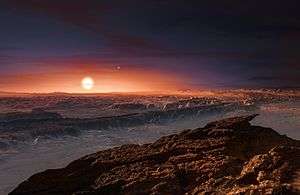V830 Tau b
| Exoplanet | List of exoplanets | |
|---|---|---|
 Credit: Mark A. Garlick / markgarlick.com | ||
| Parent star | ||
| Star | V830 Tau | |
| Constellation | Taurus | |
| Right ascension | (α) | 04h 33m 10.033s |
| Declination | (δ) | 24° 33′ 43.38″ |
| Distance | 427±10 ly (131±3 pc) | |
| Spectral type | M0–1 | |
| Mass | (m) | 1.00±0.05 M☉ |
| Radius | (r) | 2.0±0.2 R☉ |
| Age | 0.002 Gyr | |
| Orbital elements | ||
| Semi-major axis | (a) | 0.057±0.001[1] AU |
| Orbital period | (P) | 4.93±0.05 d |
| Physical characteristics | ||
| Mass | (m) | 0.77[1] MJ (245 M⊕) |
| Discovery information | ||
| Discovery date | June 20, 2016 | |
| Discoverer(s) | ||
| Discovery method | Radial velocity | |
| Discovery status | Submitted | |
V830 Tau b is an exoplanet orbiting around the young T Tauri star V830 Tau, about 427 light-years (131 pc) away from Earth in the constellation of Taurus. The exoplanet has a young age of only about 2 million years.[2][3][4]
Characteristics
Orbit and mass
V830 Tau b orbits its parent star every 4.93 days at a distance of 0.057 AU from its parent star.[1] This is about 7x closer to the host star than the planet Mercury is to the Sun. Its mass is about 77% that of Jupiter, and, because it is orbiting very close to its parent star, it is classified as a hot Jupiter.
Host star and age
The host star, V830 Tau, is a T Tauri star that is the same mass of the Sun, but twice the radius. It has a surface temperature of 4250 ± 50 K. In comparison, the Sun has a surface temperature of 5778 K.[5] The star's age is estimated to be about 2 million years old, which makes it a very young star. For comparison, the Sun is 4.6 billion years old. The star has not yet fully contracted to become a main sequence star, which ties in with its bloated radius but similar mass to the Sun. Given its mass, it will likely be on the main sequence portion of its lifetime for about 10 billion years, much like the Sun.
Discovery
Significance
Previously, before the discovery of V830 Tau b (and a slightly older planet named K2-33b, with an age around 5-10 million years), TW Hya b was discovered and disproven and PTFO 8-8695 b / CVSO 30 b was discovered with an age equally young and an orbit even closer. The yet unconfirmed objects are pending confirmation.[6] The discovery of V830 Tau b, K2-33b and PTFO 8-8695 b / CVSO 30 b proves that the formation and migration of close-in giant planets can occur on a timescale of only a few million years. The new discoveries support planet-disc interactions as the most likely mechanism for efficiently producing young hot Jupiters.[6]
See also
References
- 1 2 3 "V830 Tau b". Retrieved 2016-06-22.
- ↑ Newborn Giant Planet Grazes its Sun, IRAP / OMP Press Release, 2016 Jun 20
- ↑ "'Hot Jupiter' planet orbiting newborn star surprises scientists" CBC News http://www.cbc.ca/news/technology/hot-jupiter-1.3419412
- ↑ "Discovery of 'baby' planets sheds light on planet and solar system formation" The Guardian
- ↑ Fraser Cain (15 September 2008). "Temperature of the Sun". Universe Today. Retrieved 19 February 2011.
- 1 2 J.-F. Donati; et al. (20 June 2016). "A hot Jupiter orbiting a 2-million-year-old solar-mass T Tauri star". Nature. Retrieved 23 June 2016.
Coordinates: ![]() 04h 33m 10.033s, +24° 33′ 43.38″
04h 33m 10.033s, +24° 33′ 43.38″

.jpg)
